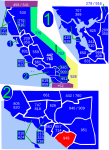El Toro High School
1973 establishments in CaliforniaAC with 0 elementsEducational institutions established in 1973High schools in Orange County, CaliforniaInternational Baccalaureate schools in California ... and 3 more
Lake Forest, CaliforniaPublic high schools in CaliforniaUse mdy dates from November 2019
El Toro High School is a public high school in Lake Forest, California, United States. It is one of five high schools in the Saddleback Valley Unified School District (SVUSD) and serves Lake Forest and its district of Portola Hills and a small portion of east Irvine. "El Toro" was the name of the community from the 1870s until a referendum in 1991. The school has served the area since 1973. The current principal of the school is Terri Gusiff.
Excerpt from the Wikipedia article El Toro High School (License: CC BY-SA 3.0, Authors).El Toro High School
Toledo Way,
Geographical coordinates (GPS) Address External links Nearby Places Show on map
Geographical coordinates (GPS)
| Latitude | Longitude |
|---|---|
| N 33.6375221 ° | E -117.6889403 ° |
Address
El Toro High School
Toledo Way 25255
92630
California, United States
Open on Google Maps







